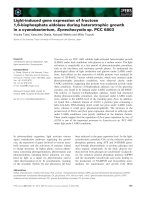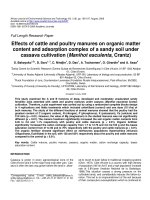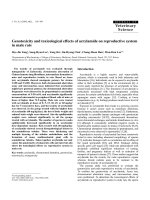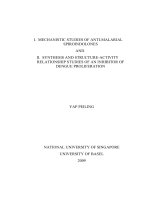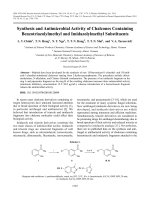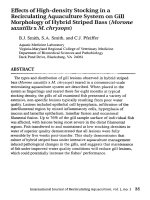Toxicological effects of Chlorpyrifos on growth, chlorophyll a synthesis and enzyme activity of a cyanobacterium spirulina (Arthrospira) platensis
Bạn đang xem bản rút gọn của tài liệu. Xem và tải ngay bản đầy đủ của tài liệu tại đây (273.66 KB, 11 trang )
Int.J.Curr.Microbiol.App.Sci (2018) 7(6): 2980-2990
International Journal of Current Microbiology and Applied Sciences
ISSN: 2319-7706 Volume 7 Number 06 (2018)
Journal homepage:
Original Research Article
/>
Toxicological Effects of Chlorpyrifos on Growth, Chlorophyll a Synthesis
and Enzyme Activity of a Cyanobacterium Spirulina (Arthrospira) platensis
G. Rathi Bhuvaneswari1, C. S. Purushothaman2, P. K. Pandey3,
Subodh Gupta1, H. Sanath Kumar1 and S. P. Shukla1*
1
ICAR - Central Institute of Fisheries Education, Mumbai, India
ICAR - Central Marine Fisheries Research Institute, Cochin (Retd), India
3
College of Fisheries, Central Agricultural University, Lembucherra, India
2
*Corresponding author
ABSTRACT
Keywords
Chlorpyrifos, Acute
Toxicity, Spirulina
Article Info
Accepted:
20 May 2018
Available Online:
10 June 2018
Chlorpyrifos, is one of the most widely used organophosphorus insecticides for
agricultural activities, and it is highly toxic to non-target organisms. This paper aims to
acquire the experimental data on the eco-toxicological effects of Chlorpyrifos and the data
can support the assessment of toxicity on the phytoplankton. The microalgae S. platensis
was employed to evaluate toxicity of Chlorpyrifos by means of measuring the specific
growth rate, generation time, percent growth inhibition, the pigment content of chlorophyll
a and carotenoid and the antioxidant enzyme super oxide dismutase. In this study, the
results showed that EC50 values was found to be 33.65 mg L-1, indicating the Chlorpyrifos
had a relatively limited growth of algae during the acute toxicity experimental period. The
growth of the microalgae was significantly affected at 40mg L−1 of Chlorpyrifos, showing
growth inhibition after 72h of exposure. Biochemical properties, including carotenoid,
chlorophyll and antioxidant enzymes of C. vulgaris were influenced by Chlorpyrifos at
relatively high concentrations. Moreover, when algae were exposed to Chlorpyrifos, SOD
activity was significantly enhanced compared to control.
Introduction
India is primarily an agriculture-based country
with more than 60-70 per cent of its
population dependent on agriculture. India’s
fast growing population is projected to cross
1.3 billion by 2020 (Kanekar et al., 2004).
In the current agricultural practices, a wide
range of pesticides are often extensively used
with the aim of increased production. Such
pesticides are toxic to humans, plants and
animals (Ghosh and Philip 2006). The
quantum of organophosphorous insecticide
has increased as it serves as an alternative to
organochlorine and carbamate pesticides
because of their efficiency and relatively
lower persistence (Shreekumar et al., 2017).
These organophosphorus insecticides can
contaminate
surface
waters
through
unintentional drift of aerial spraying, surface
run off and wet deposition (Sabater and
Carrasco,
2001).
Environmental
contamination due to the excessive use of
2980
Int.J.Curr.Microbiol.App.Sci (2018) 7(6): 2980-2990
pesticides has become a great concern to the
public and to environmental regulatory
authorities.
Among the organophosphorous insecticide,
one of the widely used insecticide is
Chlorpyrifos [0, 0-diethyl 0-3, 5, 6-trichloro 2-pyridinyl-phosphorothioate] (Cho et al.,
2002). It is effective against a broad spectrum
of insect pests on a variety of crops like
cotton, vegetables, fruits, sugarcane, golf turf
grass and residential pest control.In India,
chlorpyrifos was the second most used
agricultural insecticide during 2013 2014,with a production of 9540 tons
(Shreekumar et al., 2017. It has low water
solubility, 2mgL-1, but it is highly soluble in
many organic solvents. Chlorpyrifos has high
soil sorption co-efficient (Kd = 13.4 to 1862
mL/g) depending on the soil type with a halflife of 10 to 120 days in different soil. (Pandey
and
Singh,
2004).
Like
other
organophosphorous pesticides, its insecticidal
action is due to the inhibition of the enzyme
acetylcholinesterase,
resulting
in
the
accumulation of the neurotransmitter,
acetylcholine, at nerve endings (Kanekar et
al., 2004), this results in the excessive
transmission of nerve impulses, which causes
a potential risk to the humans and other
organisms.
Freshwater phytoplankton species show a
variable sensitivity to pesticides. Generally,
photosynthesis and growth of phytoplankton
are negatively affected byexposure to
pesticides (Shoaib et al., 2011). It is estimated
that these microalgae may account for 40 to
45% of oceanic production and are considered
as more productive than all the worlds’
rainforests (Mann, 1999) and any negative
impact caused on phytoplankton would have
deleterious effect.
These pesticides are often toxic to freshwater
organisms found in the environment. Due
attention is required to study the impact of
organophosphorous insecticide onnontarget
organisms in the aquatic environment. Microalgae need special attention considering the
ecological position in the food chain. They are
at the base of aquatic food web as primary
producers. They play a significant role in
nutrient cycle and oxygen production
(Asselborn et al., 2015). Few reports are
available on the effects of chlorpyrifos on
nontarget aquatic organisms (Asselborn et al.,
2015). Studies conducted reveals that some
algae
can
bioaccumulate
pesticide
(Subashchandrabose et al., 2013) and hence
can play a key role in the transport of this
organic contaminants through the food chain
to higher trophic levels (Wang and Wang,
2005).
Cyanobacteria,
Spirulina
platensisa
multicellular, filamentous micro algae, with
high nutritional value due to rich protein,
carbohydrates, essential fatty acids, vitamins,
minerals, carotenes, chlorophyll a and
phycocyanin, is used as a food supplement for
humans and animals. This photosynthetic
prokaryotes, which plays a key role in
photosynthetic fixation of energy and its
transfer to higher trophic levels (Lee et al.,
2001).
Researchers have reported that cyanobacterial
photosynthesis, growth and heterocyst
differentiation is significantly reduced or
inhibited by herbicides and pesticides (Shoaib
et al., 2012). Due to nutritional, ecological and
economic properties Spirulina platensis has
been the area of research. (Ali and Saleh,
2012).
The aim of this study was to evaluate the
effects of different concentrations of the
organophosphorus insecticide chlorpyrifos on
the growth, pigment and protein content of the
cyanobacterium,
Spirulina
(Arthrospira)
platensis.
2981
Int.J.Curr.Microbiol.App.Sci (2018) 7(6): 2980-2990
Materials and Methods
Toxicity assay
The indoor culture of microalgae
Toxicity studies were carried out in various
concentrations viz. 10, 20, 40, 60, 80 and 100
mg L-1 of CP solution. These concentrations
were obtained by the appropriate dilution of
the stock solution of CP in respective media.
Simultaneously controls were also prepared
for each concentration by adding the same
amount of acetone to that of test solutions,
without CP in the algal medium.
The indoor batch cultivation of S. platensis
was carried out in Erlenmeyer flasks (250, 500
and 1000 mL). The indoor culture was
maintained in plant growth chamber with an
illumination of 3500 ± 100 lux using compact
fluorescent lamps (Philips, 23 W). The light
intensity was measured using lux meter (LX103, Taiwan). The photoperiod was fixed at
12:12 hour light and dark periods.
The temperature was maintained at 24 ± 2oC.
The cultures were shaken twice in a day to
ensure the proper mixing of the algal
suspension. A closed airlift indoor culture unit
of 20 L capacity was used for the continuous
culture of algae and the cultures were aerated
using an air injection device which supplied
air at the bottom of the aspirator bottle, and
the air-flow was adjusted to a level that
ensured proper mixing of the culture.
Selection of Growth Medium
The pure culture of S. platensis was
subcultured in modified Nallayam Research
Centre medium (Bhuvaneswari G.R. et al.,
2014) under specified photoautotrophic
conditionsin indoor airlift cultures. The
composition of the growth medium isconsist 5 g NaCl, 2.5 g NaNO3, 0.01 g FeSO4.7H2O,
0.5 g K2SO4, 0.16 g MgSO4.7H2O, 8 g
NaHCO3, and 0.5 g K2HPO4 per litre.
Preparation of stock and working test
solution of Chlorpyrifos (CP)
Chlorpyrifos (purity ≥99% Chlorpyrifos),
purchased from Sigma Aldrich, the USA was
used for the experiments. A stock solution of
CP (2000mg L-1) was prepared freshly prior to
the experiment by dissolving required amount
of CP in Acetone.
Algal species and culture conditions
Toxicity experiment was conducted according
to OECD guidelines 201 (OECD, 2006), with
certain modifications when necessary. The
inoculum of S. platensis was prepared in
mNRC medium for the experiment, two days
before the test to ensure that the algal cells
exposed to CP are in exponential phase.
The exponentially growing algal culture was
harvested by centrifugation and resuspended
in CP solution of graded concentrations in the
medium. The culture density for all the
experiments was maintained at 3 x 105 cells
mL-1.
Three replicates at each test concentration
including control were incubated for 72 hrs
under
the
following
photoautotrophic
conditions, specified earlier. The cultures were
manually shaken twice a day, i.e. in morning
and evening to resuspend any settled cells.
Samples were analyzed at every 24 hrs time
interval by measuring the direct optical
density at 750 nm to calculate the specific
growth rate and generation time, SOD activity
and protein content using a double beam UVvisible
spectrophotometer
(MOTRAS
Scientific, New Delhi).
The number of algal cells was counted using
Sedgewick Rafter cell counter (Partex
Products, Mumbai) using a light microscope.
2982
Int.J.Curr.Microbiol.App.Sci (2018) 7(6): 2980-2990
μt = mean value of cell counts of the treatment
groups
Analytical procedures
Specific growth rate and generation time
The specific growth rate (K) of the alga was
calculated by using the formula given by
Kratz and Myers (1955):
2.303 logNt−logN0
K (day−1) = --------------------------(Tt− T0)
Where N0 is the initial optical density at 750
nm at time T0 and
Nt is the final optical density at time Tt when
culture is in exponential phase
The generation time (G) was calculated by
using the formula:
0.693
G (days) = -----------K
Where K is the specific growth rate
Test endpoint
The test endpoint was measured in terms of
inhibition of growth, expressed as the
logarithmic increase in biomass (in terms of
cell counts) during the exposure period.
Percent inhibition (in terms of cell counts) was
calculated as:
(μc−μt)
%I = -------------- X 100
μc
Median effective concentration (EC50) of
CP for microalgae S. platensis
72-h EC50 of CP for S. platensis was
calculated using probit analysis (Finney,
1971). EC50 of CP is the concentration of the
test substance that results in 50% reduction in
growth or algal cells within the stated
exposure period.
Extraction and analysis of chlorophyll a
and carotenoid
Algal cultures from all controls and treatments
of volume 15 mL were taken after 72 h
exposure with various concentrations of CP
used for toxicity experiment. The cultures
were centrifuged (Eltek Microprocessor Highspeed Research refrigerated centrifuge, MP
400 R, India) at 7700 g for 10 minutes at 4°C.
The supernatants were discarded, and 15 mL
of N, N-dimethyl formamide (DMF) was
added to the remaining pellets and kept for 24h for incubation at the room temperature.
After the incubation, it was centrifuged at
7700 g for 10 minutes. The supernatants were
collected in separate tubes, and optical
densities were measured at prescribed
wavelengths (664, 647 and 461 nm). The
pigments (chlorophyll-a (Moran, 1982) and
carotenoid (Chamovitz et al., 1993)) present in
S. platensis was calculated as follows:
Chlorophyll−a (μg mL−1) = OD664×11.92
Where:
Carotenoid (μg mL−1)
(0.046×OD664)] ×4
%I = Percent inhibition in cell counts;
Enzyme assay
μc = mean value of cell counts in the control
group;
Assessment of antioxidant enzyme is
necessary to estimate the microalgal cell’s
2983
=
[OD461
−
Int.J.Curr.Microbiol.App.Sci (2018) 7(6): 2980-2990
tolerance and response to CP. For this
purpose, 5mL of the microalgal suspension
was withdrawn from the culture at a regular
time interval and centrifuged at 4500 rpm for
10 min at 4oC. The biomass pellet was washed
with distilled water to remove unnecessary
traces of the medium and the centrifuged
again.
The recovered cell pellet was resuspended in
0.1 M Tris HCl (pH 7.4), sonicated for 5 min
at 4oC and centrifuged at 10,000 rpm for 10
min. The cell lysate supernatant collected after
centrifugation was used to determine the
activities of SOD. The amount of enzyme that
caused a 50%decrease in the nitroblue
tetrazolium reduction is referred as one unit of
SOD activity (Kurade et al., 2016).
Data analysis
The 72-h median effective concentration EC50
of CP for S. platensis was calculated using
probit analysis, SPSS 21.0.
Further, the toxicity experiments were
statistically analysed using SPSS 21.0 in
which data were subjected to one-way analysis
of variance (ANOVA) and when differences
observed were significant, the means were
compared by Duncan multiple range tests, at a
level of significance of 0.05 (p < 0.05).
Results and Discussion
Influence of CP on growth rates and
generation time
CP could suppress the growth of S. platensis
in a concentration-dependent manner during
72 h exposure reaction period. Compared with
control groups, CP at all studied
concentrations can significantly inhibit the
growth of the algae. The specific growth rate
of alga was decreased up to 40 mg L-1, while
no growth detected at exposure to higher
concentration. Generation time (G) presented
a similar response pattern to the specific
growth rate (Table 1).
Percent growth inhibition
Based on the number of cells in the controls
and treatments, percent inhibition of growth
was calculated post 72-h of the experiment. A
significant difference (p < 0.05) in percent
growth inhibition of S. platensis was observed
among the various concentrations of CP
exposed groups. Low concentrations (10 mg
L-1) of CP had minor effects on the growth of
S. platensis. The highest percent inhibition
(54.64%) occurred at 40 mg L-1 CP
concentration (Figure 1).
The EC50 for the % growth inhibition at the
end of the bioassay was calculated and was
found as 33.65 mg L-1 of CP with a confidence
interval (95%).
Effect of CP on
carotenoid content
chlorophyll-a
and
The content and composition of pigment were
measured after 72-h of exposure to CP. The
pigments, chlorophyll-a, and carotenoids were
measured and found to have significant
(p<0.05) reduction in level in all the CP
exposed groups when compared with control.
The chlorophyll-a was 9.37 µgmL-1 in control
(Table 2) wherein it was reduced to 6.53
µgmL-1 in highest of CP i.e. 40 mg L-1. A 32.2
% decrease in the Chlorophyll-a content was
recorded in 40mg L-1(Fig 2) CP exposed
group in comparison to control. The
carotenoids content ranged from 3.10 to1.66
µgmL-1 in control and treatments. The
carotenoids content was significantly reduced
in comparison to control and among treatment,
and also significant between treatments was
found in a dose-dependent manner. The
carotenoid content was reduced by 48.33% in
exposure to 40 mgL-1 concentration.
2984
Int.J.Curr.Microbiol.App.Sci (2018) 7(6): 2980-2990
Table.1 Growth rates of S. platensis after 72 h exposure to various concentration of CP
Concentration of
SGR (day-1)
CP (mg L-1)
Generation Time
(days)
0
0.24b±0.02
2.88a±0.19
10
0.23b±0.01
3.01a±0.03
20
0.13a±0.01
5.21b±0.07
40
0.10a±0.01
6.84c±0.67
Table.2 Effect of various concentrations of CP on the pigment composition of S.platensis
Concentration of CP (mgL-1)
Chl a (µgmL-1)
Carotenoids (µgmL-1)
0 (control)
9.37b±0.27
3.10c±0.11
10
8.88b±0.64
2.90c±0.01
20
8.40b±0.09
2.38b±0.23
40
6.53a±0.16
1.66a±0.05
Data are represented in mean ± SE, n=3. The data labels represent the significant difference (p<0.05).
Fig.1 Percent inhibition of growth in S. platensis exposed to different concentration of CP
2985
Int.J.Curr.Microbiol.App.Sci (2018) 7(6): 2980-2990
Fig.2 Effect of various concentrations of CP on the pigment composition of S. platensis. Data are
represented in mean ± SE, n=3. The data labels represent the significant difference (p<0.05)
Fig.3 Effect of Chlorpyrifos on SOD Enzyme
Effect on Antioxidant Enzyme –SOD
The SOD activity in S.platensis cells in the
presence of CP was enhanced due to the
exposure to various concentration over the
untreated cells. There was significant
(p<0.05) increase in SOD enzyme activity
between the control and treatment (Fig 3).
However, there was no significant difference
was found between the treatments.
The microalgae, which are the primary
producers and in the base of the aquatic food
chain, plays a key role in the structure and
2986
Int.J.Curr.Microbiol.App.Sci (2018) 7(6): 2980-2990
function of an ecosystem. Among the aquatic
organisms, it is reported that sensitivity of
algae and cyanobacteria are high. They are
very important indicators used to assess the
toxicity of chemicals released to the aquatic
environment (Burkiewicz K., 2005). To
understand the toxicity of a compound, algal
toxicity tests are widely used based on
assessing the growth inhibition of the
microalgae.
In the present study, the toxicity of CP to S.
Platensis was evaluated by phytotoxicity tests
based on growth inhibition, the percent
reduction in the growth of algae with
pesticide culture compared with control
cultures without the pesticide as reported by
Oliveira et al., (2007). At higher
concentration of pesticide, there was a highly
significant reduction of Specific growth rate
and proportionate increase in percent
inhibition of growth was observed. This could
be because of the change in the proportion of
pesticide concentration and the existing
number of algal cells (Oterler et al., 2016).
This dose-dependent reduction in growth was
observed by many researchers (Asselborn et
al., 2015; Wang and Wang, 2016).
The
commission
of
the
European
Communities (1996) classified different toxic
classes based on the EC50value of the
toxicant. Based on that CP is found to be
harmful to S.platensis because the EC50 value
is 33.65 mgL-1 which is in the classified range
(10-100 mgL-1). Wang and Wang (2016)
found the EC50 value ranging from 27.80
mg/L (24 h) to 25.80 mg/L (72 h) in a
cyanobacterial species (Merismopedia sp)
against chlorpyrifos. Sun et al., (2015) found
the EC50 value of a cyanobacterium which is
21.13 µ mol L-1, which is too low compared
to our results.
Chlorophyll is considered as the sensitive
biomarker when exposed to toxicants because
of their role in photosynthetic electron
transport activity (Huang et al., 2012).
Organophosphorus insecticides are known to
affect the photosynthetic process of
microalgae by interfering with the synthesis
of chlorophyll a (Caceres et al., 2008). The
growth, synthesis of chlorophyll a and the
photosynthetic process of the microalgal cells
was
significantly inhibited at
high
concentrations of CP (Wong and Chang,
1988). Our results are in agreement with
Oterler, (2016) as he also found a negative
correlation of Chlorophyll content with
increase in pesticide concentration. A similar
pattern of drop-in Chlorophyll_a content and
decreased synthesis in the cells causing
decreased protein content was found in the
results of the studies conducted by Ou et al.,
(2003) and Xia et al., (2007). Chlorophyll
content is directly related to the biomass.
Hence, logically, the reduction in biomass
obviously leads to decrease in Chlorophyll
concentration.
Carotenoid also serves as sensitive
biomarkers
for
monitoring
aquatic
contaminants. Its role is to deactivate the
excited chlorophyll to avoid the stressinduced damage of the photosynthetic system
triggered by the formation of reactive oxygen
species (ROS) with exposure to toxicants
(Xiong et al., 2016). Like, the reduction in
chlorophyll pigments, carotenoids content
also was greatly inhibited at relatively high
concentrations of CP indicating CP is toxic to
S. Platensis metabolism which is supported
by the results of the study by Asselborn et al.,
(2015). Our results shows that % decrease in
carotenoid content is higher than the %
decrease in chlorophyll-a content, revealing
that carotenoid is more sensitive to CP than
chlorophyll-a. The decrease in carotenoid
contents might be associated with the lipid
peroxidation along with the potassium
leakage
at
high
concentrations
of
organophosphorus pesticide as reported by
2987
Int.J.Curr.Microbiol.App.Sci (2018) 7(6): 2980-2990
Chen et al., (2011) and Kurade et al., (2016).
Singh et al., (2013) found that the herbicide
Anilofos caused inhibitory effects on
photosynthetic pigments of the test organism
in a dose-dependent manner. The organism
exhibited 60, 89, 96, 85 and 79% decrease in
chlorophyll a, carotenoids, phycocyanin,
allophycocyanin
and
phycoerythrin,
-1
respectively, in 20 mg L anilofos on day six.
Their findings support our results well.
The SOD activity in S. platensis cells in the
presence of CP was enhanced due to the
exposure to various concentration of CP
overuntreated cells. This result is in
agreement with various researchers, as they
have found significant and progressive
increase in SOD activity to the increasing
concentration of pesticide (Asselborn et al.,
2015; Kurade et al., 2016). Many researchers
had proved that organic pollutants tend to
stimulate overproduction and accumulation of
reactive oxygen species (ROS), including
superoxide anions (O2•−) and hydrogen
peroxide (H2O2) (Torres et al., 2008). Once
the microalgal cells are exposed to pollutants,
the cellular detoxification system is initiated
by synthesis of SOD to put an end to the toxic
stress caused due to ROS (Li et al., 2009).
Superoxide dismutase (SOD) serve as
sensitive biomarkers, which can be used as
early warnings of pollution. It the first line of
defense system of the cell against ROS,
catalyses the disproportionation of superoxide
anions O2 •−, to produce H2O2 and O2. This is
followed by the action of catalase which
disintegrate hydrogen peroxide into water and
oxygen. If these enzymes SOD and catalase
fails to catalyse the process of disintegration
of ROS it may lead to programmed cell death
(Torres et al., 2008). An increase in the SOD
levels of microalgae as a response to
oxidative stress induced by pesticides has
been reported earlier (Singh et al., 2013;
Kurade et al., 2016).
The present study demonstrates that the
exposure of microalgae to the insecticide
Chlorpyrifosposes negative impact. The
growth of S. platensis was inhibited after the
exposure to different concentrations of CP
with the specific growth rate decreasing
progressively upon the increase in the
pesticide concentration. There was also a
significant difference between the control and
treatment in parameters like percent growth
reduction, Chlorophyll a, carotenoid and
antioxidant enzymes. Thus, it reveals that
effects of Chlorpyrifos are not only restricted
to target organisms but also causes an adverse
impact on non-target organisms especially
phytoplankton, which plays an important role
in the functioning of aquatic ecosystems as
sole primary producers.
References
Ali, S.K. and Saleh, A.M., 2012. Spirulina—
an overview. Int J Pharm Pharm
Sci, 4(3), pp.9-15.
Asselborn, V., Fernández, C., Zalocar, Y. and
Parodi, E.R., 2015. Effects of
chlorpyrifos on the growth and
ultrastructure
of
green
algae,
Ankistrodesmusgracilis. Ecotoxicology
and environmental safety, 120, pp.334341.
Bhuvaneswari, G. Rathi, S. P. Shukla, M.
Makesh, S. Thirumalaiselvan, S. Arun
Sudhagar, D. C. Kothari, and Arvind
Singh, 2013. "Antibacterial Activity of
Spirulina (Arthospiraplatensis Geitler)
against
Bacterial
Pathogens
in
Aquaculture." Israeli
Journal
of
Aquaculture-Bamidgeh 65 :1-8.
Burkiewicz K., Synak R. andTukaj Z.
Toxicity of Three Insecticides in a
Standard Algal Growth
Cáceres, T., Megharaj, M. and Naidu, R.,
2008. Toxicity and transformation of
fenamiphos and its metabolites by two
micro
algae
Pseudokirchneriella
2988
Int.J.Curr.Microbiol.App.Sci (2018) 7(6): 2980-2990
subcapitata
and
Chlorococcum
sp. Science
of
the
total
environment, 398(1-3), pp.53-59.
Chamovitz, D., Sandmann, G. and
Hirschberg, J., 1993. Molecular and
biochemical
characterization
of
herbicide-resistant
mutants
of
cyanobacteria reveals that phytoene
desaturation is a rate-limiting step in
carotenoid biosynthesis. Journal of
Biological
Chemistry, 268(23),
pp.17348-17353.
Chen, H. and Jiang, J.G., 2011. Toxic effects
of chemical pesticides (trichlorfon and
dimehypo)
on
Dunaliellasalina. Chemosphere, 84(5),
pp.664-670.
Chen, W.J. Zheng, Y.S. Wong, F. Yang,
(2008). Selenium-induced changes in
activities of antioxidant enzymes and
content of photosynthetic pigments in
Spirulina platensis.J. Integr. Plant Biol.
50: 40–48.
Cho, C. M., Mulchandani, A. and Chen W.,
2002. Bacterial cell surface display of
organophosphorus hydrolase for selective
screening of improved hydrolysis of
organophosphate
nerve
agents.
ApplMicrobiolBiotechnol., 68: 20262030.
Finney, D.J., 1971. Probit Analysis.
Cambridge University Press, London.
Ghosh, P. K. and Philip, L., 2006.
Environmental significance of atrazine
in aqueous systems and its removal by
biological processes: An overview.
Global NEST Journal, 8: 159-178.
Huang, L., Lu, D., Diao, J. and Zhou, Z.,
2012. Enantioselective toxic effects and
biodegradation
of
benalaxyl
in
Scenedesmus
obliquus. Chemosphere, 87(1), pp.7-11.
Inhibition
Test
with
Scenedesmus
subspicatus, Bull. Environ. Contam.
Toxicol., 74, 1192-1198, (2005).
J.Integr. Plant Biol. 50 (2008) 40–48.
Kanekar, P. P., Bhadbhade, B., Deshpande, N.
M. and Sarnaik, S. S., 2004.
Biodegradation of organophosphorus
pesticides. Proc Indian NatnSci Acad.,
70: 57-70.
Kratz, W. A., Myers, J. (1955): Nutrition and
growth of several blue green algae.
Amm. J. Bot. 42, 282–287.
Kurade, M.B., Kim, J.R., Govindwar, S.P.
and Jeon, B.H., 2016. Insights into
microalgae mediated biodegradation of
diazinon
by Chlorella
vulgaris:
Microalgal tolerance to xenobiotic
pollutants
and
metabolism. Algal
research, 20, pp.126-134.
Lee, O.H., Williams, G.A. and Hyde, K.D.,
2001. The diets of Littorariaardouiniana
and L. melanostoma in Hong Kong
mangroves. Journal of the Marine
Biological Association of the United
Kingdom, 81(6), pp.967-973.
Li, X., Ping, X.M. Sheng, Z.B.Wu, L.Q. Xie,
(2005). Toxicity of cypermethrin on
growth, pigments, and superoxide
dismutase of Scenedesmus obliquus,
Ecotoxicol. Environ. Saf.60: 188–192.
Lowry, O.H., Rosebrough, N.J., Farr, A.L.
and Randall, R.J., 1951. Protein
measurement with the Folin phenol
reagent. Journal
of
biological
chemistry, 193(1), pp.265-275.
Mann, D.G. 1999. The species concept in
diatoms. Phycologia, 38(6): 437-495.
Moran, R., Porath, D., 1980. Chlorophyll
determinations in intact tissue using
N,N-dimethylformamide. Plant Physiol.
65, 478–479.
Öterler, B. and Albay, M., 2016. The effect of
5 organophosphate pesticides on the
growth of Chlorella vulgaris Beyerinck
[Beijerinck] 1890. International Journal
of Research Studies in Biosciences. 4,
pp.26-33.
Pandey, S. and Singh, D. K., 2004. Total
bacterial and fungal population after
chlorpyrifos and quinalphos treatments in
2989
Int.J.Curr.Microbiol.App.Sci (2018) 7(6): 2980-2990
groundnut (Arachis hypogaea) soil.
Chemosphere, 55:
Sabater, C. and Carrasco, J.M., 2001. Effects
of the organophosphorus insecticide
fenitrothion on growth in five
freshwater
species
of
phytoplankton. Environmental
toxicology, 16(4), pp.314-320.
Shoaib, Nafisa, Pirzada Jamal Ahmed
Siddiqui, and Halima Khalid, 2012
"Toxicity of chlorpyrifos on some
marine cyanobacteria species." Pakistan
Journal of Botany, 43:1131-1133.
Shoaib, Nafisha., Jamal, P., Siddiqui, A., Ali,
A., Burhan, Z.U.N. and Shafique, S.,
2011. Toxicity of pesticides on
photosynthesis of diatoms. Pakistan
Journal of Botany, 43(4), pp.2067-2069.
Singh, D.P., Khattar, J.I.S., Kaur, M., Kaur,
G., Gupta, M. and Singh, Y., 2013.
Anilofos
tolerance
and
its
mineralization by the cyanobacterium
Synechocystis sp. strain PUPCCC
64. PLoS One, 8(1), p.e53445.
Sreekumar, S. and Devatha, C.P., 2017.
Biodegradation of Chlorpyrifos from
agricultural soil. Journal of Emerging
Research in Management &Technology,
6: 2278-9359.
Subashchandrabose, S.R., Ramakrishnan, B.,
Megharaj, M., Venkateswarlu, K. and
Naidu,
R.,
2013.
Mixotrophic
cyanobacteria and microalgae as
distinctive biological agents for organic
pollutant
degradation. Environment
international, 51, pp.59-72.
Sun, K.F., Xu, X.R., Duan, S.S., Wang, Y.S.,
Cheng, H., Zhang, Z.W., Zhou, G.J. and
Hong, Y.G., 2015. Ecotoxicity of two
organophosphate pesticides chlorpyrifos
and dichlorvos on non-targeting
cyanobacteria
Microcystis
wesenbergii. Ecotoxicology, 24(7-8),
pp.1498-1507
Torres, M.A., M.P. Barros, S.C.G. Campos,
E. Pinto, S. Rajamani, R.T. Sayre, P.
Colepicolo,
(2008).
Biochemical
biomarkers in algae and marine
pollution: a review, Ecotoxicol.
Environ. Saf. 71: 1–15.
Wang, X. and Wang, W.X., 2005. Uptake,
absorption efficiency and elimination of
DDT
in
marine
phytoplankton,
copepods
and
fish. Environmental
Pollution, 136(3), pp.453-464.
Wong, P.K. and Chang, L., 1988. The effects
of
2,
4-D
herbicide
and
organophosphorus
insecticides
on
growth, photosynthesis, and chlorophyll
a
synthesis
of
Chlamydomonas
reinhardtii
(mt+). Environmental
Pollution, 55(3), pp.179-189.
Xiong, J.Q., Kurade, M.B., Abou-Shanab,
R.A., Ji, M.K., Choi, J., Kim, J.O. and
Jeon, B.H., 2016. Biodegradation of
carbamazepine
using
freshwater
microalgae Chlamydomonas mexicana
and Scenedesmus obliquus and the
determination
of
its
metabolic
fate. Bioresource
technology, 205,
pp.183-190.
How to cite this article:
Rathi Bhuvaneswari G., C. S. Purushothaman, P. K. Pandey, Subodh Gupta, H. Sanath Kumar
and Shukla S. P. 2018. Toxicological Effects of Chlorpyrifos on Growth, Chlorophyll a
Synthesis and Enzyme Activity of a Cyanobacterium Spirulina (Arthrospira) platensis.
Int.J.Curr.Microbiol.App.Sci. 7(06): 2980-2990. doi: />
2990
